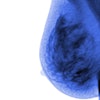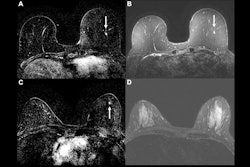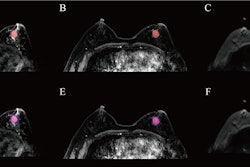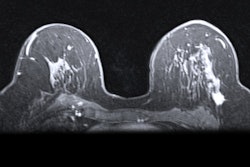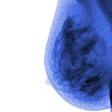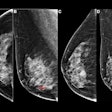Abbreviated MRI may be feasible as a first-round screening method for women with extremely dense breasts, according to research published May 20 in Radiology.
A team led by Wouter Veldhuis, MD, PhD, from University Medical Center Utrecht in the Netherlands found that this approach led to high diagnostic accuracy that was comparable to that of the full multiparametric protocol, and with shorter reading and scanning times.
“Our results suggest that in a screening setting, an ultrashort, under five-minute acquisition time, dynamic contrast enhanced-only protocol suffices, showing that the additional sequences, including diffusion-weighted imaging [DWI], T2-weighted imaging, and delayed post-contrast T1-weighted images and curve kinetics, do not provide additional diagnostic information for making a recall/no-recall decision,” Veldhuis told AuntMinnie.
The Dense Tissue and Early Breast Neoplasm Screening (DENSE) trial, which took place from 2011 to 2016, showed that supplemental MRI screening lowered interval cancer rates in women with dense breasts. Since then, imaging societies have recommended that supplemental MRI be used to further screen women with dense breasts.
However, issues tied to cost, capacity, and accessibility have limited the modality’s clinical utility in this area. The researchers highlighted that shorter MRI protocols could help minimize costs while delivering high-quality image results.
Veldhuis and colleagues compared the diagnostic accuracy of different abbreviated screening breast MRI protocols with that of the full multiparametric protocol in the DENSE trial. They focused on identifying the minimal protocol needed to maintain high diagnostic accuracy.
For the study, seven radiologists performed incremental readings of first-round screening MRI scans in women with extremely dense breasts. The women’s findings were negative for cancer at mammography.
The researchers added different sequences in four incremental steps. The first step included both high-temporal low-spatial and low-temporal high-spatial dynamic T1-weighted series, up to 120 seconds after contrast agent injection. The final step added all full-protocol sequences.
 Abbreviated axial MRI images show a 7-mm irregular mass with irregular margin (arrows) in the right upper inner quadrant with early rapid enhancement (BIRADS 4). The participant was recalled and underwent an MRI-guided vacuum-assisted biopsy that showed sclerosing adenosis with microcalcifications and usual ductal hyperplasia and focal apocrine metaplasia. On the full-protocol images (not shown), the lesion was T2-weighted hypointense and showed diffusion restriction and washout kinetics in the delayed phase, characteristics that would not have reversed the decision to recall the participant.RSNA
Abbreviated axial MRI images show a 7-mm irregular mass with irregular margin (arrows) in the right upper inner quadrant with early rapid enhancement (BIRADS 4). The participant was recalled and underwent an MRI-guided vacuum-assisted biopsy that showed sclerosing adenosis with microcalcifications and usual ductal hyperplasia and focal apocrine metaplasia. On the full-protocol images (not shown), the lesion was T2-weighted hypointense and showed diffusion restriction and washout kinetics in the delayed phase, characteristics that would not have reversed the decision to recall the participant.RSNA
The first-round screening included 518 MRI scans from 518 women with a median age of 53. This included 83 breast cancers, 68 of which were invasive and 15 were ductal carcinomas in situ (DCIS) cases.
The team reported that the abbreviated protocol led to shorter scanning and reading times while maintaining sensitivity and specificity values comparable to those of the full protocol.
Comparison between abbreviated, full screening breast MRI protocols | |||
Measure | Full multiparametric protocol | Abbreviated protocol | p-value |
Sensitivity | 85.9% | 84.3% | 0.68 |
Specificity | 75.8% | 73.9% | 0.39 |
Reading time | 96.4 seconds | 49.7 seconds | < 0.001 |
And depending on the scanner vendor, the abbreviated protocol led to scanning times decreasing by 70% to 80%, the team found.
Velduis said that reducing the exam time and noise levels could improve the patient experience, which may increase screening participation rates.
“More importantly, with respect to access, abbreviated breast MRI provides a faster alternative to conventional MRI while still maintaining high diagnostic accuracy for making a recall/no-recall decision,” he told AuntMinnie. “These shorter reading and scan times may allow implementation of MRI in national screening programs, making it available for all women with dense breasts.”
Veldhuis added that the team has started the multicenter randomized-controlled DENSE-2 trial together with 15 hospitals across the Netherlands. In this national population-based screening program, women with dense breasts will undergo both abbreviated MRI and contrast-enhanced mammography after a negative screening mammogram. The researchers are focusing on interval cancer rates, additional cancer detection rates, false positive rates, and tumor stage distribution for women undergoing either modality.
Having such evidence for a concise protocol would move the imaging field forward in delivering efficient and effective patient care, according to an accompanying editorial written by Masako Kataoka, MD, PhD, and Maya Honda, MD, PhD, from Kyoto Medical University in Japan.
“Combined with improvement in scanning workflow [needle placement, positioning, and scanning], abbreviated MRI can be a feasible option for patients with extremely dense breasts needing supplemental screening,” the duo wrote.
They highlighted that the research “adds a valuable piece to the ongoing conversation on how best to optimize breast MRI screening.”
The full study can be found here.


